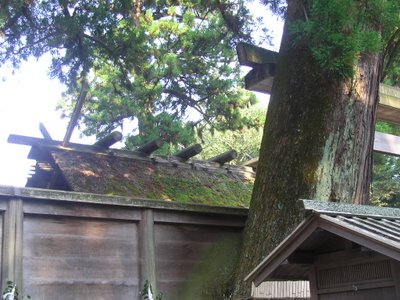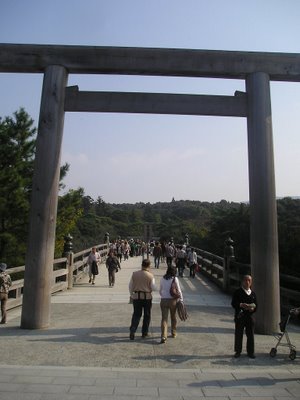The most sacred Shinto shrines in Japan are 90 minutes away by train from Nagoya in Ise. I decided to go there during my first weekend in Nagoya, still jittery from my subway uncertainties. Ogino-san has the kindness of showing me the way to the station of the train to Ise, providing me English maps, and writing down queries for direction in Japanese in case I get lost. So the next day which is a Saturday, I took the subway to the Kintetsu Line at Nagoya’s Central Station. I am sure I was at the right place but it is not the same one Ogino-san took me. And so I spent 1 hour trying to figure out how to get a ticket to Ise because the ticket vending machines don’t seem to understand what I want it to do. I almost decided to turn back before taking a leap of faith by asking a station staff for direction. After a few minutes of broken Japanese, broken English, and lots of gestures, I was on my way to Ise.
There was one train transfer at the Matsusaka Station before I arrived at the Iseshi Station. There, I asked my way to the shrines. The Ise Shrines are actually 2 separate shrines: the Outer Shrine or Geku and the Inner Shrine or Naiku. Geku, a 5-minute walk from the train station, was my first destination. It is believed to have been established in the 5th century and dedicated to Toyouke --- the kami of clothing, food, and housing. It was unusually colder inside Geku and I felt eerie, as if I was transported to another world and the ancient huge trees are heavenly sentinels watching my every move. I moved with the mass of people, hoping from one minor shrine to another, giving an offering of Y1, Y10, and Y50 coins --- whispering my apologies that I am just a trainee from a poor country --- and saying my prayers in what I thought was the Shinto way. That is, holding my palms together in the usual prayer mode while repeatedly bowing my head then clapping loudly at the end.



Shinto shrines have 7 components: (1) the torii which is the approach to the shrine with a pair of koamino (i.e. guardian dogs or lions) at both sides; (2) the purification through where hands and mouth are cleaned before approaching the main hall; (3) the main and offering hall which is the most sacred place in the shrine; (4) usually a stage for bugako dances and no theaters; (5) the ema where wishes are written; (6) a place for omikuji or fortune papers; and (7) the shimenawa which mark the boundary of sacred places. By tradition, the Ise Shrines are rebuilt every 20 years which is the reason for the vacant lot beside each main shrine.
The Inner Shrine or Naiku is a 15-minute bus ride from Geku. There was a traffic jam midway the trip so I decided to follow some passengers and walked the rest of the way. The entrance to Naiku is a dramatic wooden bridge after the torii. It looks pretty much like Geku except that the eerie feeling is more subdued perhaps because of the multitude of people who crowded the shrine. Naiku is dedicated to Amaterasu and is believed to have been established earlier than Geku in the 3rd century. It is where the sacred mirror is stored. Taking photos of the main shrine is prohibited but I somehow managed to have one.



Outside the inner shrine is Oharaimachi --- the 1-kilometer old approach to Naiku. Today, it looks more like a shopping district but has retained its rustic elegance because of the reconstruction of houses from the Meiji era that used to line the road. Ogino-san told me later that I was very fortunate because my visit to Ise coincided with a festival where representatives of other Shinto shrines around Japan come together once in several years. There was a parade, which is similar to the Philippine prusisyon, where wooden altar-like structures are carried by men in frenzy, which are like our karosa. That is when I understood the traffic jam and the throng of people who were there that day. I had my first taste of sake at Oharaimachi where I also brought a wooden toy for my youngest son Balong. I left Ise via the Ujiyamada Station feeling tired but light. I slept the rest of the way to Nagoya and slept more in the subway ride to the Issha Station.

PHOTOS (top to bottom):
1) Mossy roof and ancient trees at the Geku main hall.
2) A shimenawa at Geku.
3) Worshippers in one of Geku’s minor altars.
4) The main torii and at the entrance of the wooden bridge to Naiku.
5) The vacant lot beside Naiku’s main hall where a new shrine will be built after a cycle of 20 years.
6) Worshippers pray and give their offerings at the curtain-draped window fronting Naiku’s sacred shrine.
7) Naiku’s sacred shrine is inside this enclosure.
8) Oharaimachi’s prusisyon.
There was one train transfer at the Matsusaka Station before I arrived at the Iseshi Station. There, I asked my way to the shrines. The Ise Shrines are actually 2 separate shrines: the Outer Shrine or Geku and the Inner Shrine or Naiku. Geku, a 5-minute walk from the train station, was my first destination. It is believed to have been established in the 5th century and dedicated to Toyouke --- the kami of clothing, food, and housing. It was unusually colder inside Geku and I felt eerie, as if I was transported to another world and the ancient huge trees are heavenly sentinels watching my every move. I moved with the mass of people, hoping from one minor shrine to another, giving an offering of Y1, Y10, and Y50 coins --- whispering my apologies that I am just a trainee from a poor country --- and saying my prayers in what I thought was the Shinto way. That is, holding my palms together in the usual prayer mode while repeatedly bowing my head then clapping loudly at the end.



Shinto shrines have 7 components: (1) the torii which is the approach to the shrine with a pair of koamino (i.e. guardian dogs or lions) at both sides; (2) the purification through where hands and mouth are cleaned before approaching the main hall; (3) the main and offering hall which is the most sacred place in the shrine; (4) usually a stage for bugako dances and no theaters; (5) the ema where wishes are written; (6) a place for omikuji or fortune papers; and (7) the shimenawa which mark the boundary of sacred places. By tradition, the Ise Shrines are rebuilt every 20 years which is the reason for the vacant lot beside each main shrine.
The Inner Shrine or Naiku is a 15-minute bus ride from Geku. There was a traffic jam midway the trip so I decided to follow some passengers and walked the rest of the way. The entrance to Naiku is a dramatic wooden bridge after the torii. It looks pretty much like Geku except that the eerie feeling is more subdued perhaps because of the multitude of people who crowded the shrine. Naiku is dedicated to Amaterasu and is believed to have been established earlier than Geku in the 3rd century. It is where the sacred mirror is stored. Taking photos of the main shrine is prohibited but I somehow managed to have one.



Outside the inner shrine is Oharaimachi --- the 1-kilometer old approach to Naiku. Today, it looks more like a shopping district but has retained its rustic elegance because of the reconstruction of houses from the Meiji era that used to line the road. Ogino-san told me later that I was very fortunate because my visit to Ise coincided with a festival where representatives of other Shinto shrines around Japan come together once in several years. There was a parade, which is similar to the Philippine prusisyon, where wooden altar-like structures are carried by men in frenzy, which are like our karosa. That is when I understood the traffic jam and the throng of people who were there that day. I had my first taste of sake at Oharaimachi where I also brought a wooden toy for my youngest son Balong. I left Ise via the Ujiyamada Station feeling tired but light. I slept the rest of the way to Nagoya and slept more in the subway ride to the Issha Station.

PHOTOS (top to bottom):
1) Mossy roof and ancient trees at the Geku main hall.
2) A shimenawa at Geku.
3) Worshippers in one of Geku’s minor altars.
4) The main torii and at the entrance of the wooden bridge to Naiku.
5) The vacant lot beside Naiku’s main hall where a new shrine will be built after a cycle of 20 years.
6) Worshippers pray and give their offerings at the curtain-draped window fronting Naiku’s sacred shrine.
7) Naiku’s sacred shrine is inside this enclosure.
8) Oharaimachi’s prusisyon.

No comments:
Post a Comment